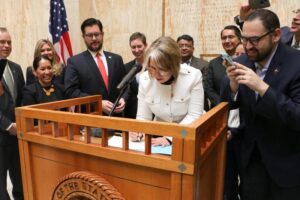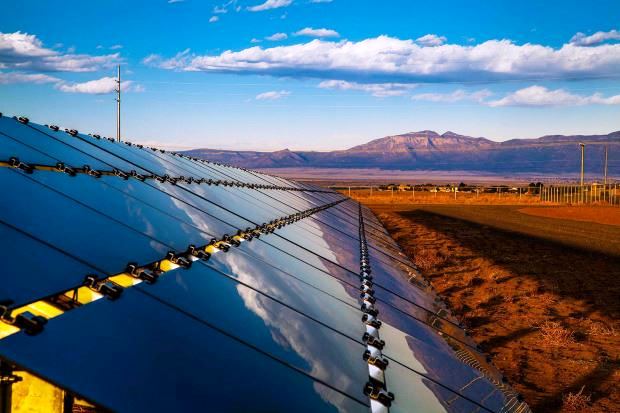
 With a new law mandating a full transition to a zero-carbon power grid by 2045, New Mexico has become one of a handful of U.S. states driving the national conversation on clean energy. Ending coal-fired power generation in New Mexico will bring clear benefits—cutting carbon emissions, improving air quality, lowering electricity rates—but it will also come with some economic pain. The Energy Transition Act aims to ease the effects of the shift from coal, both for electric utilities and for workers, while positioning the state to develop good jobs in the renewable energy sector. [Photo: Office of the New Mexico Governor]
With a new law mandating a full transition to a zero-carbon power grid by 2045, New Mexico has become one of a handful of U.S. states driving the national conversation on clean energy. Ending coal-fired power generation in New Mexico will bring clear benefits—cutting carbon emissions, improving air quality, lowering electricity rates—but it will also come with some economic pain. The Energy Transition Act aims to ease the effects of the shift from coal, both for electric utilities and for workers, while positioning the state to develop good jobs in the renewable energy sector. [Photo: Office of the New Mexico Governor]
Governor Michelle Lujan Grisham—who took office at the beginning of this year after a campaign that emphasized her commitment to clean energy—signed the bill into law on March 22, calling it “transformational.”
“This is a really big deal,” she said at the signing ceremony. “The Energy Transition Act fundamentally changes the dynamic in New Mexico.”
At more than 80 pages long (the bill’s formal title alone fills a page and a half), the Energy Transition Act is a comprehensive, complex piece of legislation designed to accelerate the move toward renewable energy and away from coal. It requires the state’s utilities to ensure that renewable energy sources comprise an increasingly larger share of total retail electricity sales in New Mexico—20 percent by 2020, 40 percent by 2025, 50 percent by 2030, and 80 percent by 2040.
“No later than January 1, 2045, zero carbon resources shall supply one hundred percent of all retail sales of electricity in New Mexico,” the law specifies. Rural electric cooperatives have a little more time and a little more leeway to reach that standard.
Unlike some states that have set energy goals or laid out policies, New Mexico has established legal requirements for utilities, Noah Long, a senior attorney with the National Resources Defense Council (NRDC), said in an interview.
“It’s not just a slogan here in New Mexico, it’s the law,” said Long, who is based in the state capital, Santa Fe, and lobbied for the bill during the two-month legislative session at the beginning of the year. He noted that the Energy Transition Act is “appropriately technology-neutral” on how to reach the renewable energy benchmarks, leaving open the opportunity to capitalize on technological developments over the next 25 years.
The most ambitious target is in the near term, with the share of renewables set to double between 2020 and 2025. “I see this not only as realistic but actually saving customers money and really beginning a clean energy economic development opportunity in the state that we’ve been missing,” Long said.
Given the precipitous drop in the cost of solar and wind energy in recent years—and the abundance of those resources in a desert southwest state like New Mexico—it makes sense to move quickly, Long said. “We’re losing money every day we don’t use those technologies,” he said.
Although the law eventually requires 100 percent zero carbon, the maximum requirement for renewables is 80 percent. That difference of 20 percentage points could come from natural gas with carbon capture or from energy storage solutions or other technologies.
 New Mexico is the third U.S. state to commit to 100 percent clean electricity, after Hawaii and California. Several other states have recently taken steps in that direction, including Washington, Maryland, New York, and Illinois.
New Mexico is the third U.S. state to commit to 100 percent clean electricity, after Hawaii and California. Several other states have recently taken steps in that direction, including Washington, Maryland, New York, and Illinois.
In New Mexico, a state with deep economic challenges, many leaders see renewable energy as an economic development opportunity.
Although the Energy Transition Act was spearheaded by Democrats—who won the governorship and both chambers of the state legislature in last year’s elections—the bill ultimately passed with bipartisan support, particularly in the Senate. Half of the state’s Republican senators voted for it. Many environmental groups, labor unions, Native American leaders, and others also backed the legislation, as did the state’s largest investor-owned utility, Public Service Company of New Mexico (PNM).
“PNM is fully aware of the challenges this legislation places squarely on our company, but we know there is no better place than New Mexico to grow the renewable energy economy,” Patricia Vincent-Collawn, President and CEO of PNM Resources (the utility’s parent company), said in a news release after the bill was signed. The utility had already started a transition to cleaner energy, but coal still accounts for 56.1 percent of its energy mix, followed by nuclear power, at 21.8 percent, and natural gas, at 12.3 percent. Wind, solar, and geothermal resources together make up the remainder, just under 10 percent.
Critics of the Energy Transition Act questioned whether the legislation was too generous to PNM by mitigating the pain to shareholders of shutting down the state’s largest coal-fired plant, the 847-megawatt San Juan Generating Station, and its adjacent coal mine. PNM is the majority owner of the San Juan operation, which is slated for closure in 2022. The law paves the way for the utility to use a financial mechanism called “securitization” to finance the abandonment of such assets.
The idea is that the utility will issue low-interest “energy transition bonds”—eventually to be repaid by ratepayers—to pay off the high-interest debt on its investment in the San Juan plant. The utility will forego a return on that investment but will recoup the principal and avoid having to take a huge write-down. Ratepayers will benefit, according to the NRDC’s Long, because the low interest rate on the AAA-rated bonds will bring down the cost of electricity.
In what Long believes is one of the strengths of the New Mexico law, some of the savings derived from the financing scheme will be reinvested in severance pay and job training for workers at power plants that are forced to close because of the transition to clean energy. The law provides up to $20 million in such funding per qualifying generating plant, with the funds allocated to three state agencies: the Economic Development Department, the Department of Workforce Solutions, and the Indian Affairs Department.
The San Juan Generating Station and its adjacent coal mine are located in the northwestern corner of the state, near the Navajo Nation, and together the facilities employ around 450 people. PNM also plans to end its participation in the nearby Four Corners Power Plant in 2031.
The law provides for consultation with Indian nations, tribes, and pueblos about steps forward, and establishes apprenticeship programs designed to retrain displaced workers and promote economic development in communities affected by plant shutdowns.
Navajo Nation President Jonathan Nez told the state’s largest newspaper, the Albuquerque Journal, that the legislation reflects his nation’s embrace of renewable energy. “We’d like to be the leader in Indian Country,” he said.
As New Mexico’s new governor put it at the signing ceremony, “This legislation is a promise to future generations of New Mexicans, who will benefit from both a cleaner environment and a more robust energy economy with exciting career and job opportunities. Crucially, the Energy Transition Act does not leave affected workers and neighbors behind. We look out for each other. With this law, we seal that promise.”
 View Map
View Map